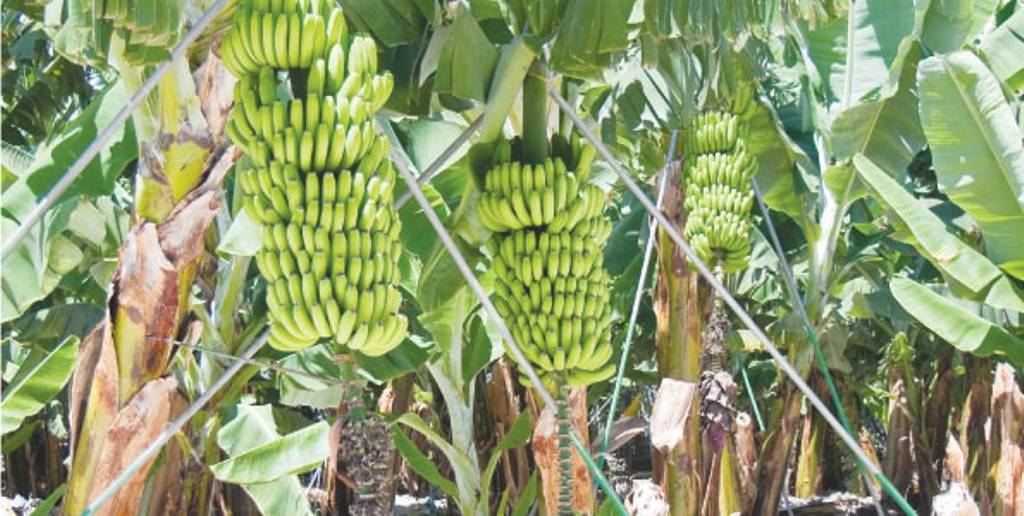
Banana is one of the oldest fruits known to mankind. It is also known as “Apple of Paradise” & “Tree of Wisdom”. Banana is the second largest produced fruit after mango in India. Every part of the banana plant has a ready use.
Cultural operations are agricultural practices carried out to assist the crop for complete regeneration.
Cultural operations in Banana
Desuckering: During the growth of the mother plant, the suckers arise from its rhizomes from time to time. If all these suckers are allowed to grow, the mother plant loses its vigor & normal development resulting in lower bunch weight & total yield. Therefore, the suckers should not be allowed to grow near the parent plant till the mother plant commences flowering.
At flowering (six months after planting), a vigorous growing sword sucker should be allowed to grow & one more sucker is encouraged to shoot out from the soil when the parent plant matures its fruits. Thus, the parent plant has completed its life, it has only two suckers.
When the mother plant is harvested & removed, the first sucker which is 6 months old takes the lead & becomes the mother plant in the next generation & thus the successive generations of suckers arising one after the other at 6 months intervals perpetuate.
Removal of all suckers up to flowering of mother plant & maintaining only one follower afterward is the best Desuckering practice. However, under high-density planting, it is better to leave the follower after harvesting 75-80% of the plant crop so that uniform cultural practices can be followed.
It has been observed that sucker removal had no effect on yield in the first harvest, but yield in the second harvest was highest in plants left with one sucker followed by plants left with 2 or 3 suckers & was lowest in plants without removal of suckers.
Desuckering or pruning is the removal of unwanted suckers. It is done by either cutting off the sucker or the heart may be destroyed without detaching the sucker from the parent plant. Sometimes kerosene is poured into the cavity left after digging the sucker. In south India, a crowbar with a chisel-like end is used for damaging the sucker.
Trashing: it is the removal of undesirable material from the banana field like dried, diseased & decayed leaves, pseudostem after harvest, male bud, last end of inflorescence & withered floral parts.
Mattocking: After harvesting the bunch, the plant stem should be cut in stages at least after 30-45 days to facilitate mobilization of the nutrients from the mother to the developing ratoon plant. The pseudostem should be cut leaving a stump of about 0.6m in height.
Wrapping of bunches: It is covering of bunches with polythene or gunny cloth that protects the fruits from intense heat, hot wind, etc. & improves the color of the fruit.
Tipping: It is the removal of the heart or male bud. The large heart-shaped flower bud contains infertile male flowers in reddish scale leaves. This heart flower bud persists even after the fertile flowers have developed & formed into a bunch.
It should be cut soon after the bunch is formed, otherwise it is likely to use up some of the food, which would otherwise go to the development of fruits. It is a practice recommended for improving the appearance of the bunch as well as to ward off “fingertip disease”.
Removal of floral remnants: The removal of dried & persistent floral remnants present at the apex of the fruit or finger helps in preventing the spread of fungal diseases. These floral remnants provide shelter to some of the fungal spores.
Propping: It is a method by which support is given to banana-bearing plants with the help of bamboo, casuarinas, or eucalyptus poles, protecting them from bending or falling down due to heavy bunch load & from heavy damage by wind. It is very essential for tall varieties.
Earthing up: It should be done during the rainy season to provide drainage & to avoid waterlogging at the base. It is to be done once in 2 or 3 months to prevent soil erosion from the basins & to avoid direct contact of water with pseudostem. Due to earthing up, there are fair chances of formation of the good root system. It is better than whole rows of bananas are strongly ridged up about 10” high.
Weeding: In the first four months after planting, it is necessary to remove weeds. The stirring of the soil by the spade after every 6 or 7 irrigations is necessary to maintain its tilth & absorptive power.
Weeds can also be checked by the use of herbicides. Diuron @ 4kh per hectare & simazine @6 kg per hectare control grasses & broad-leaved weeds when applied after planting & repeated 30 days after planting. Glyphosate @ 1 kg a.i. per hectare at 30 & 60 days after planting of suckers is recommended.
Banana is sensitive to 2,4-D & hence the phenoxy compounds are not used.
Nutrient Sprays: Spraying of a mixture containing 2% urea & potassium Di-hydrogen phosphate immediately after the emergence of inflorescence stalk helps in increasing the size of the bunch & fruit content.
















